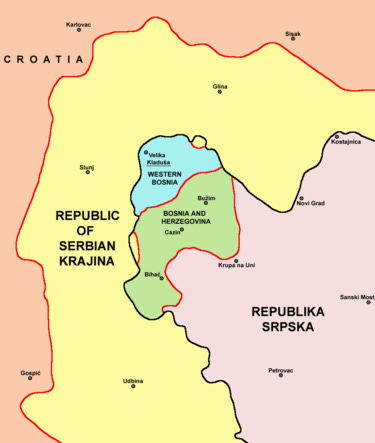November 1994.
The Army of the Republic of Bosnia and Herzegovina launched its largest offensive against Bosnian Serb forces since the beginning of the war in the spring of 1992, with the aim of regaining all the lost territory [you can listen to the latest episode of BarBalkans - Podcast here].
Advancing in two directions - from Sarajevo towards the enclaves of eastern Bosnia, and from Bihać towards the heart of Republika Srpska - the Bosniak forces caused a series of heavy defeats to Bosnian Serbs, supported by the surprise attack of the Croatian Defence Council against Ratko Mladić’ forces.
However, the illusion of a comeback fades quickly. This time Bosniaks find themselves only a few steps away from the abyss.
The final push
On November 3 the converging offensives from the north (Bosniaks) and south (Bosnian Croats) on Kupres led to the greatest joint military success of the two armies. For the first time, a town occupied by Bosnian Serbs is recaptured.
This is a remarkable achievement both for its strategic implications - Kupres is a center of enormous importance for the control of central Bosnia and western Herzegovina - and for its political implications.
Little more than six months after the Washington Agreement, the alliance between Bosnian Croats and Bosniaks has proven to be effective not only in the institutional theory of the Federation of Bosnia and Herzegovina, but also on the battlefield.
On the other side, Bosnian Serb forces are experiencing their darkest hour. Undersized, demoralized, and unable to counter the simultaneous offensives, they seem to be on the brink of the collapse at the beginning of November.
While the 5th Corps of the Bosnian Army, led by General Atif Dudaković, is trying to break the Serbian encirclement in western Bosnia, the Bosnian Croat and Croatian forces seem ready to unleash an attack against Milan Martić’ Serbo-Croats to recapture Knin, the capital of the Republic of Serbian Krajina.
Faced with the abyss for the Bosnian and Croatian Serbs, the President of Republika Srpska Radovan Karadžić proclaims a state of war. But most of all, the President of Serbia Slobodan Milošević intervenes and does not abandon his ‘compatriots’ despite the political disagreements of recent months.
The Serbian counter-offensive
Milošević’ support includes over 9,000 soldiers - including regulars, volunteers, and mercenaries - 42 tanks and 32 armored vehicles to reinforce the Bosnian Serb forces led by Mladić.
Operation Morning changes the situation on the ground within a few days, leading to a disastrous retreat by Dudaković’ 5th Army Corps. The Bosnian army loses almost all the territory it gained in the last two weeks.
Dudaković faces increasing difficulties due to the remnants of the People’s Defense of Western Bosnia after the fall of the self-proclaimed Autonomous Region.
Based in the Croatian Krajina, Fikret Abdić’ armed groups breach the Bihać enclave and, on November 17, successfully marche on Velika Kladuša, the Bosnian separatist stronghold lost in August.
The Bosnian 5th Army Corps faces attacks from Bosnian Serbs in the south/south-east and from Serbo-Croats and Bosnian secessionists in the north/north-west. This created the paradoxical situation of Serbian military operations being conducted from a protected area in Croatia into a security zone in Bosnia, violating the state border between Croatia and Bosnia.
As a result, the Bosniaks are no longer able to defend their positions. The town of Bihać now stands on the verge of collapse.
The agony of Bihać
On November 13, the Bosnian Serb military campaign in the Bihać enclave begins. And it shows all the double standards by the leadership of the United Nations Protection Force (UNPROFOR).
During the Bosniak offensive earlier this month, French authorities ordered their 400 blue helmets to withdraw from Bihać after two years of service. Only 1,200 Bangladeshi blue helmets - totally unprepared and short of weapons - protect the Bosniak enclave at its most desperate moment.
The commander of UNPROFOR in Bosnia and Herzegovina Michael Rose undermines the NATO attack on the Bosnian Serb positions, ordering his ground observers not to signal any targets to hit.
The Secretary General of the United Nations Boutros Boutros-Ghali even blocks the press from travelling to Bihać to inform international opinion about what is happening in the enclave of western Bosnia.
The passivity - or worse, appeasement - of UNPROFOR towards the violent Serbian offensive on Bihać becomes clear when napalm and fragmentation bombs hit the enclave, where the headquarters of the Bosnian 5th Army Corps is based.
The planes that bomb Bihać take off from Udbina airport, located just across the Croatian border, in the heart of the Republic of Serbian Krajina.
On November 19, the UN Security Council adopts Resolution 958, authorizing NATO to intervene on the territory of the Croatian Krajina if necessary to defend the UN security zones in Bosnia and Herzegovina.
However, to get the support of the Russian Federation, the UN Security Council immediately passes Resolution 959, authorizing NATO to also strike the Bosnian army in the event of war operations conducted from UN protected areas, which coincide with their largest enclaves.
In other words, Bosniaks can do nothing more than defend themselves against Bosnian Serb assaults, without the possibility of militarily reconquering the territory they lost after the start of the war in April 1992.
While fighting already rages the suburbs of Bihać, on November 12 a squadron of 36 NATO planes attacks the airport of Udbina, hitting the runway and two anti-aircraft batteries, but spares the hangar housing 15 planes, 10 helicopters, and fuel depots.
This is only a warning to the Serbian armed forces, but it shows once again the ongoing clash between NATO and UNPROFOR. While NATO leadership would have liked to unleash a more massive bombing, the attack has been restricted by the opposition of the UNPROFOR commanders precisely because of the appeasement policy.
Bosnian Serbs and Croatian Serbs understand everything, and do not back down. The runway at Udbina airport is repaired within a couple of weeks, and the planes resume bombing Bihać, taking off from Udbina in violation of Resolution 958.

On the battlefield, the tanks continue to advance towards the center of Bihać. The pattern is the same already seen in Srebrenica in March 1993 and Goražde in April 1994.
The Bosnian Serb army intensifies the siege on the Bosnian enclave. NATO strikes some positions in a demonstration action, but only when the besiegers are too close to the defenders to effectively use air support. Serbian tanks stop just before violating the safe area, thereby avoiding an inevitable reaction. A proposal for demilitarization freezes the status quo, which favors Mladić’ forces.
The only difference in Bihać is that the defeated have the option to surrender to Abdić’ forces. And UN Secretary General Boutros-Ghali blames the Bosniaks for the siege of Bihać, citing their only real military offensive.
The support of readers who every day gives strength to this project - reading and sharing our articles - is essential to realize all that you have read and listened to, and even more.
If you know someone who can be interested in The Yugoslav Wars podcast, why not give them a gift subscription?
Behind every original product comes an investment of time, energy and dedication. With your support BarBalkans will be able to elaborate new ideas, interviews and collaborations.
Here is the archive of The Yugoslav Wars:
Here you can find a summary of the past years:


















Share this post